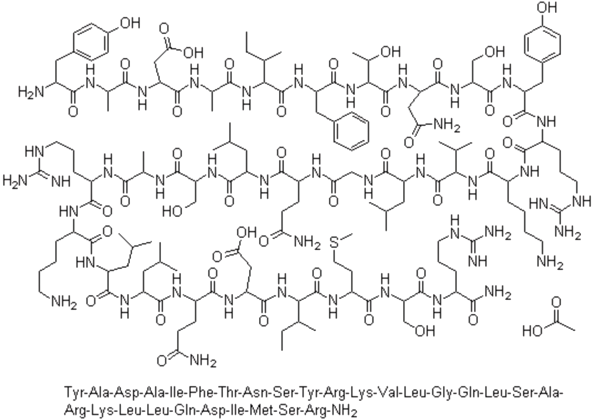Sermorelin
Potential management of adult-onset GH insufficiency
Exploration of anti-aging therapies by enhancing endogenous GH production
Sermorelin is a synthetic peptide comprising the first 29 amino acids of human growth hormone-releasing hormone (GHRH). It is used to stimulate the pituitary gland to increase endogenous growth hormone (GH) production, primarily for diagnostic evaluation and treatment of growth hormone deficiency.
Mechanism of action
Sermorelin binds to GHRH receptors in the anterior pituitary, promoting the transcription of GH mRNA and subsequent GH secretion. This stimulation leads to a pulsatile release of GH, closely mimicking the body’s natural secretion patterns. Unlike exogenous GH administration, sermorelin’s action is regulated by the body’s feedback mechanisms, reducing the risk of overdose and preserving pituitary function.
Notable Studies
A study published in Clinical Interventions in Aging highlighted that sermorelin stimulates pituitary GH secretion without causing tachyphylaxis, making it a potential alternative for managing adult-onset GH insufficiency.
Research in PubMed indicated that daily subcutaneous administration of sermorelin at 30 µg/kg body weight effectively promoted growth in prepubertal children with idiopathic GH deficiency.
Risk Associated
Redness, swelling, or pain at the injection site
Headaches
Nausea
Dizziness
These side effects are typically mild and transient. Serious adverse reactions are rare but may include allergic responses.
Dosage
The typical dosage of sermorelin ranges from 200 to 500 micrograms per day, administered via subcutaneous injection, preferably at bedtime to align with the body’s natural GH secretion cycle. Dosage may be adjusted based on individual response and treatment goals.
External link


Sermorelin
Potential management of adult-onset GH insufficiency
Exploration of anti-aging therapies by enhancing endogenous GH production
Mechanism of action
Sermorelin binds to GHRH receptors in the anterior pituitary, promoting the transcription of GH mRNA and subsequent GH secretion. This stimulation leads to a pulsatile release of GH, closely mimicking the body’s natural secretion patterns. Unlike exogenous GH administration, sermorelin’s action is regulated by the body’s feedback mechanisms, reducing the risk of overdose and preserving pituitary function.
Risk
Associated
Redness, swelling, or pain at the injection site
Headaches
Nausea
Dizziness
These side effects are typically mild and transient. Serious adverse reactions are rare but may include allergic responses.
Notable Studies
A study published in Clinical Interventions in Aging highlighted that sermorelin stimulates pituitary GH secretion without causing tachyphylaxis, making it a potential alternative for managing adult-onset GH insufficiency.
Research in PubMed indicated that daily subcutaneous administration of sermorelin at 30 µg/kg body weight effectively promoted growth in prepubertal children with idiopathic GH deficiency.
Dosage
The typical dosage of sermorelin ranges from 200 to 500 micrograms per day, administered via subcutaneous injection, preferably at bedtime to align with the body’s natural GH secretion cycle. Dosage may be adjusted based on individual response and treatment goals.
External link
Sermorelin
Potential management of adult-onset GH insufficiency
Exploration of anti-aging therapies by enhancing endogenous GH production
Mechanism of action
Sermorelin binds to GHRH receptors in the anterior pituitary, promoting the transcription of GH mRNA and subsequent GH secretion. This stimulation leads to a pulsatile release of GH, closely mimicking the body’s natural secretion patterns. Unlike exogenous GH administration, sermorelin’s action is regulated by the body’s feedback mechanisms, reducing the risk of overdose and preserving pituitary function.

Risk
Associated
Redness, swelling, or pain at the injection site
Headaches
Nausea
Dizziness
These side effects are typically mild and transient. Serious adverse reactions are rare but may include allergic responses.
Notable Studies
A study published in Clinical Interventions in Aging highlighted that sermorelin stimulates pituitary GH secretion without causing tachyphylaxis, making it a potential alternative for managing adult-onset GH insufficiency.
Research in PubMed indicated that daily subcutaneous administration of sermorelin at 30 µg/kg body weight effectively promoted growth in prepubertal children with idiopathic GH deficiency.
Dosage
The typical dosage of sermorelin ranges from 200 to 500 micrograms per day, administered via subcutaneous injection, preferably at bedtime to align with the body’s natural GH secretion cycle. Dosage may be adjusted based on individual response and treatment goals.
External link
-
Walker RF, et al. “Sermorelin: a better approach to management of adult-onset growth hormone insufficiency?” Clinical Interventions in Aging. 2006.
-
“Sermorelin: a review of its use in the diagnosis and treatment of children with idiopathic growth hormone deficiency.” PubMed. 2007.
-
“Sermorelin Therapy Benefits, Uses, Side Effects, Risks, More.” Healthline.
-
“Sermorelin Dosage Calculator (and Dosing Chart).” Eden.
-
“Common Sermorelin Side Effects.” Concierge MD.